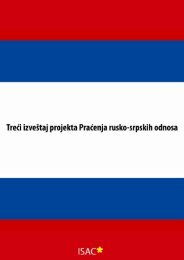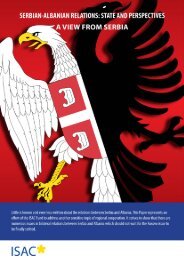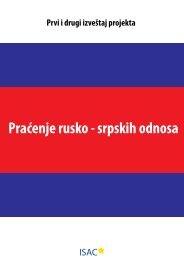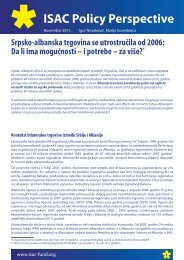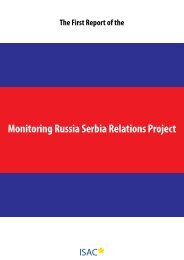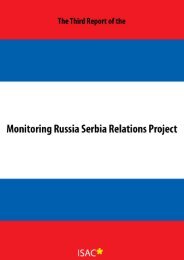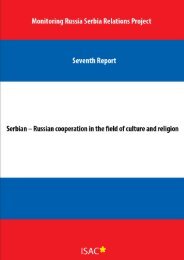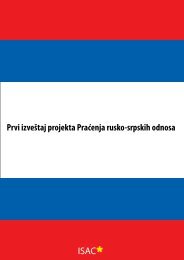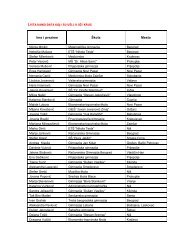the process of security sector reform - ISAC Fund
the process of security sector reform - ISAC Fund
the process of security sector reform - ISAC Fund
You also want an ePaper? Increase the reach of your titles
YUMPU automatically turns print PDFs into web optimized ePapers that Google loves.
István Gyarmati MILITARY REFORMS OF THE 1990s: LESSONS LEARNED FROM THE SUCCESSES AND FAILURES<br />
István Gyarmati<br />
Chairman <strong>of</strong> <strong>the</strong> Board, Centre for Euro-Atlantic Integration<br />
and Democracy, Budapest<br />
MILITARY REFORMS OF THE 1990S:<br />
LESSONS LEARNED FROM THE<br />
SUCCESSES AND FAILURES<br />
An overview <strong>of</strong> findings and recommendations from studies commissioned on<br />
<strong>the</strong> subject: “Defence Reforms <strong>of</strong> <strong>the</strong> 1990s: Lessons Learned”<br />
BACKGROUND: THE LEGACY OF THE COLD WAR<br />
In 1991 an historic era ended: <strong>the</strong> Soviet Union collapsed, and <strong>the</strong> Warsaw Treaty<br />
Organization was dissolved. The Cold War was over, clearly won by <strong>the</strong> West.<br />
Commonly accepted views suggest that this was a war without a shot fired, that<br />
military might did not play a significant role in <strong>the</strong> victory <strong>of</strong> democracy over<br />
Communism. This is, however, not entirely true. On <strong>the</strong> one hand, more than two<br />
hundred local wars were fought during <strong>the</strong> Cold War, many <strong>of</strong> <strong>the</strong>m being proxy<br />
wars, where <strong>the</strong> two opposing coalitions found proxies to advance <strong>the</strong>ir cause in<br />
remote or less remote parts <strong>of</strong> <strong>the</strong> world.<br />
The most important front, however, was <strong>the</strong> one in Europe. Thousands <strong>of</strong> tanks,<br />
combat aircraft, artillery pieces, armored combat vehicles and millions <strong>of</strong> soldiers<br />
faced each o<strong>the</strong>r, ready to move on a few hours notice. Hundreds <strong>of</strong> billions <strong>of</strong><br />
dollars were spent to create and maintain <strong>the</strong>se forces on both sides. The biggest<br />
concentration <strong>of</strong> force was created along <strong>the</strong> borderlines <strong>of</strong> <strong>the</strong> two alliances:<br />
along <strong>the</strong> inner-German border (do we still remember that?) and along <strong>the</strong> borders<br />
between o<strong>the</strong>r countries <strong>of</strong> <strong>the</strong> Warsaw Pact and NATO. Nuclear weapons and<br />
o<strong>the</strong>r weapons <strong>of</strong> mass destruction were considered legitimate means to fight<br />
<strong>the</strong> war, allowing for hundreds <strong>of</strong> millions <strong>of</strong> casualties to be suffered in Europe<br />
and <strong>the</strong> United States. Even <strong>the</strong> extinction <strong>of</strong> human life was on Earth being a<br />
realistic danger did not deter military and political planners to consider <strong>the</strong>se<br />
options as valid ones.<br />
66 67



